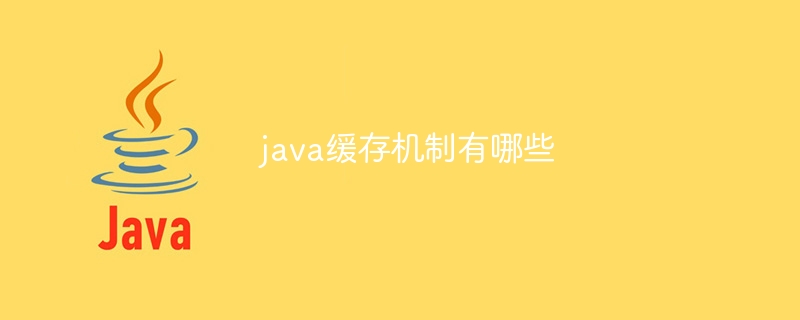Home >Java >javaTutorial >What are the java caching mechanisms?
What are the java caching mechanisms?
- 百草Original
- 2023-11-16 11:21:361899browse
Java cache mechanisms include memory cache, data structure cache, cache framework, distributed cache, cache strategy, cache synchronization, cache invalidation mechanism, compression and encoding, etc. Detailed introduction: 1. Memory cache, Java's memory management mechanism will automatically cache frequently used objects to reduce the cost of memory allocation and garbage collection; 2. Data structure cache, Java's built-in data structures, such as HashMap, LinkedList, HashSet, etc. , with efficient caching mechanisms, these data structures use internal hash tables to store elements and more.

The operating system of this tutorial: Windows10 system, Java19.0.1 version, DELL G3 computer.
As a popular programming language, Java provides a variety of caching mechanisms to improve performance and response speed. The following are the main contents of the Java cache mechanism:
1. Memory cache: Java's memory management mechanism will automatically cache frequently used objects to reduce the overhead of memory allocation and garbage collection. When an object is used frequently, the Java Virtual Machine (JVM) automatically stores it in memory so that subsequent requests can obtain the object faster. This caching mechanism is automatic and developers do not need to write caching code explicitly.
2. Data structure caching: Java's built-in data structures, such as HashMap, LinkedList, HashSet, etc., have efficient caching mechanisms. These data structures use internal hash tables to store elements and use hash codes to quickly locate elements. When performing a search or update operation on the data structure, if the element is already in the cache, the cached result is returned directly; otherwise, the position or value of the element is calculated and cached. This reduces double calculations and unnecessary memory allocations.
3. Caching framework : Java has many third-party caching frameworks to choose from, such as EhCache, Guava Cache, Caffeine, etc. These frameworks provide more flexibility and scalability and can be customized according to specific needs. They usually support multiple caching strategies, such as LRU (least recently used), LFU (least frequently used), etc. Using a caching framework can easily implement caching functions and improve application performance and response speed.
4. Distributed cache: For large applications or distributed systems, distributed cache may be needed to improve scalability and fault tolerance. Distributed caching caches data on multiple nodes so that cached data can be shared among multiple servers. Common distributed caching solutions include Redis, Memcached, Cassandra, etc. They provide a rich set of features and plug-ins that can be seamlessly integrated with other Java applications.
5. Caching strategy: Depending on different application requirements and scenarios, you can choose different caching strategies. Common caching strategies include least recently used (LRU), least frequently used (LFU), etc. These policies can determine which entries should be replaced or eliminated based on factors such as frequency of access, resource size, resource type, and more. Developers can choose an appropriate caching strategy based on the characteristics and needs of the application to improve performance and response speed.
6. Cache synchronization: In a distributed system, cache data needs to be synchronized and updated between multiple nodes. Commonly used cache synchronization technologies include TCP/IP-based communication protocols, message queue-based publish/subscribe models, etc. Through cache synchronization technology, data consistency between various nodes can be ensured and data inconsistency can be avoided.
7. Cache invalidation mechanism: The data in the cache may become invalid due to various reasons, such as data update, expiration time, etc. In order to ensure cache consistency, a cache invalidation mechanism needs to be used to handle invalid situations. Common failure mechanisms include timing failure, counter failure, condition failure, etc. Developers can choose an appropriate failure mechanism based on the characteristics and needs of the application to avoid data inconsistencies.
8. Compression and encoding: For large data or network transmission, you can consider compressing and encoding the data to reduce the transmission volume and network bandwidth consumption. Java provides a variety of compression and encoding libraries, such as gzip, bz2, zlib, etc. At the same time, the client can also decode and decompress the response for local use. Through compression and encoding technology, network transmission volume and bandwidth consumption can be reduced, and application performance and response speed can be improved.
To sum up, Java provides a variety of caching mechanisms to improve performance and response speed. These mechanisms include memory cache, data structure cache, cache framework, distributed cache, cache strategy, cache synchronization, cache invalidation mechanism, compression and encoding, etc. Choosing an appropriate caching mechanism based on specific business needs and scenarios can help developers optimize the performance and response speed of Java applications.
The above is the detailed content of What are the java caching mechanisms?. For more information, please follow other related articles on the PHP Chinese website!

